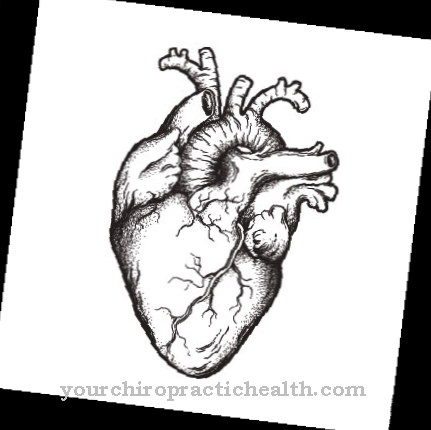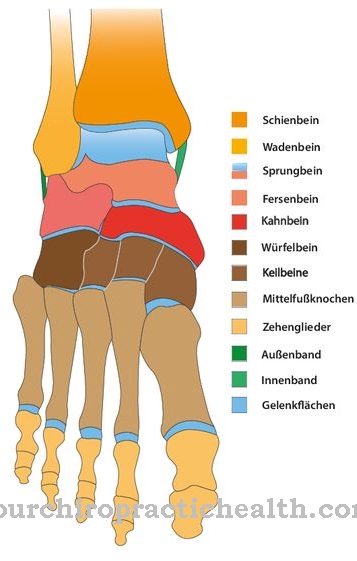The Sézary syndrome is a T-cell lymphoma and manifests itself in swelling of the skin, itching and flaking, among other things. The exact circumstances of its development have not yet been clarified, which makes treatment and prevention more difficult.
What is Sézary Syndrome?

© Daniel Vincek - stock.adobe.com
The Sézary (Baccaredda) syndrome belongs to the group of T-cell lymphomas. Lymphoma is a pathological enlargement of the lymph nodes, which can mean both swelling and a tumor. The syndrome got its name from the French dermatologist of the same name. At the Sézary syndrome is a cutaneous T-cell lymphoma that affects certain cells of the immune system. Most of those affected are over 50 years old. Men are more likely to develop Sézary syndrome than women.
causes
The cause of Sézary syndrome lies in the T cells. T cells are special cells in the immune system that are part of the white blood cells. In Sézary's syndrome, the T cells are changed and thus incorrectly trigger a defense reaction of the immune system, which primarily results in various inflammatory symptoms. The nucleus of the monocytoid and lymphocytoid cells is large and appears to be folded. In addition, these cells in Sézary syndrome are characterized by a narrow cytoplasmic border.
The cell may have several vacuoles that are grouped around the nucleus and appear like a collar. The signs are therefore very similar to the picture that also appears in another form of T-cell lymphoma, namely mycosis fungoides. Special tests can detect these abnormal cells in the skin, bone marrow, and blood in Sézary syndrome. Doctors usually use a blood and / or skin test for diagnosis.
Symptoms, ailments & signs
The most noticeable symptom of Sézary's syndrome is the extensive reddening of the skin, which doctors call erythroderma. Erythroderma is an inflammatory reaction of the human body that manifests itself superficially in the form of reddened skin all over the body. It usually causes affected tissue to lose salt, protein, and fluids, which increases the risk of infection.
In the case of Sézary's syndrome, medicine also speaks of malignant reticulemic erythroderma. It can take the form of pyoderma, which is another symptom of Sézary's syndrome as a purulent, burning inflammation. Other signs of the disease include itching, flaking, or keratinization of the skin, which medicine calls hyperkeratosis. Hyperkeratosis makes the outermost layer of skin, the striatum corneum, thicker because more keratinocytes or corneocytes are formed.
Hair loss all over the body can also be a potential sign of Sézary syndrome. The disease can also cause semicircular wrinkles. The skin hangs down in typical places such as the elbows or the buttocks because the tissue no longer holds it tight. The result is a pattern that is vaguely reminiscent of cellulite, but spreads more evenly across the skin. Typically there is also a swelling of the lymph nodes, occasionally changes to the fingernails and toenails can appear.
Diagnosis & course of disease
In addition to the skin symptoms, increased lymphocyte values can provide an initial clinical indication. Examining the blood and the cells it contains can bring clarity. The PAS response is crucial in the laboratory test. The "Periodic acid-Schiff reaction" is a staining technique that makes carbohydrates visible under the microscope. The stained parts of the cell then appear in the blue-violet color spectrum and can thus be more clearly distinguished from one another.
In the differential diagnosis, doctors must primarily rule out neurodermatitis, psoriasis and mycosis fungoides. The latter is a disease that also belongs to the T-cell lymphoma and therefore has a very similar clinical picture. Mycosis fungoides is more common than Sézary syndrome and forms knots of tissue.
Complications
In Sézary syndrome, patients suffer from various skin conditions. In most cases, the aesthetics are significantly reduced, so that most patients are ashamed of the symptoms and do not feel comfortable with it. This can also lead to the development of depression and inferiority complexes.
The patients suffer from itching and reddening of the skin. The skin itself can become very flaky or have a rash. Frequently, scars are formed as a result of permanent scratching. Furthermore, Sézary syndrome leads in many cases to hair loss that occurs all over the body. Young people in particular can become victims of bullying or teasing and also suffer from psychological disorders.
Sézary syndrome can also discolor or change the nails in general. In most cases the symptoms can be treated well. The intake of vitamin A also has a very positive effect on the disease and can limit the symptoms. There are no particular complications. Furthermore, the life expectancy of the patient remains unchanged due to Sézary syndrome.
When should you go to the doctor?
With Sézary syndrome, the person affected is in any case dependent on medical treatment from a doctor. Self-healing cannot occur, so treatment by a doctor must definitely be carried out. The earlier the doctor is consulted, the better the further course of this disease. A doctor should therefore be consulted as soon as the first complaints and symptoms of Sézary's syndrome appear. The doctor should be consulted if the person concerned suffers from reddening of the skin that occurs for no particular reason and does not go away on its own.
It spreads all over the body and leads to a significant reduction in aesthetics. Furthermore, severe itching or the formation of dandruff can indicate Sézary syndrome and should also be examined by a doctor. Most people affected by this disease also suffer from hair loss. Usually Sézary syndrome can be diagnosed by a dermatologist or a general practitioner. Further treatment depends on the exact complaints. As a rule, this disease does not reduce the life expectancy of the person affected.
Therapy & Treatment
The healing rate in Sézary syndrome is around 50 percent. A frequently used treatment method is photochemotherapy, which is also called psoralen plus UV-A (PUVA). PUVA combines irradiation with UV-A light with the use of psoralen. Psoralen is a group of natural substances. They are found in essential oils and are of vegetable origin. At PUVA, the psorals have the task of sensitizing the skin to light.
For this purpose, patients take the psoralen orally or have it applied to the skin area for which treatment is due. Creams or water solutions that contain the psoralen can also be used. Depending on which form of PUVA is used, the interval between psoralen administration and radiation can vary. The aim of PUVA is to contain the spread of abnormal cells and possibly even to suppress them completely. Treatment with retinoids pursues the same goal.
These are substances that are similar to vitamin A. Medicine uses retinoids as a means of chemotherapy and applies them mainly when Sézary syndrome is already at an advanced stage. Interferons may also be used to treat the disease. On the one hand, they are supposed to inhibit the growth of abnormal T cells and, on the other hand, activate killer cells that occur naturally in the human body.
prevention
The prevention of Sézary's syndrome mainly includes general recommendations: healthy nutrition, avoidance of potentially carcinogenic substances and a healthy lifestyle. The precise conditions in which the disease developed have not yet been conclusively clarified; this makes targeted prevention more difficult. However, more recent findings indicate that iron in the diet may also be relevant for Sézary syndrome.
Genetic causes are also up for debate: Sézary syndrome sufferers seem to be missing certain gene sequences. In addition, the research was able to find evidence of a lack of tumor suppressors that normally cause cell growth to stop.
Aftercare
The life-threatening Sézary syndrome requires comprehensive therapy with subsequent follow-up care. The latter aims to avoid the cancerous pathogens if possible. That is why it is extremely important for patients to follow their doctor's recommendations. After medical treatment, it is helpful to live consciously and eat a balanced diet.
Although there is still no conclusive knowledge about the causes of the syndrome, a health-conscious diet is helpful as a preventive measure and aftercare.Those affected can also take advantage of genetic counseling. The recovery process can be supported by general aftercare measures.
This includes sensible skin care that alleviates the redness and itching caused by the disease. Changes to the nails can also be avoided or at least reduced with the help of a balanced diet. If there is weight loss, fever, or other complications following medical therapy, an immediate medical examination is required.
People should look out for such symptoms to improve their chances of recovery. Patients can not only turn to their doctor for detailed advice. At the Max Delbrück Center in Berlin, those affected can also get comprehensive information and recommendations for treatment and aftercare.
You can do that yourself
Sézary syndrome is primarily treated with medication. The patient is prescribed MTX, prednisone and similar agents, which alleviate the symptoms and improve the complexion. Various general measures support the recovery process. Good skin care regimen will relieve itching and redness. Nail changes can be reduced with a healthy diet. The symptoms of the lymph must be treated by a doctor in any case, as various complications such as weight loss or fever can occur.
Sézary syndrome is a life-threatening condition that has poor overall prospects of recovery. All the more important is comprehensive advice from a specialist who shows ways and means to improve the quality of life and improve the prognosis. Measures such as chemotherapy or surgery should be discussed with the doctor, since the earlier treatment is started, the better the chances of recovery.
The most important self-help measure is to determine the medical options and to take full advantage of them with the support of a specialist doctor. The Max Delbrück Center for Molecular Medicine in Berlin-Buch is one of the most important institutes for Sézary syndrome research. Sick people turn to the center for the best possible advice and treatment.






.jpg)

.jpg)



















